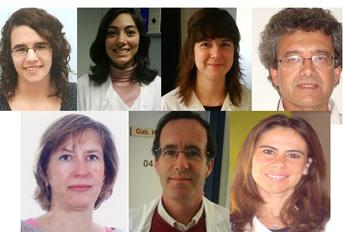Associação Portuguesa de Investigação em Cancro
Identificação de uma nova variante germinal no gene FOXE1 em doentes com cancro da tiróide familiar
Identificação de uma nova variante germinal no gene FOXE1 em doentes com cancro da tiróide familiar

As formas familiares de carcinoma não-medular da tiróide (FNMTC) representam cerca de 5% de todas as neoplasias da glândula tiroideia. Até à data, foram identificados três genes de susceptibilidade para o FNMTC (NKX2-1, DICER1 e SRGAP1). Este estudo apresentou, pela primeira vez, evidência do envolvimento a nível germinal de uma variante rara no gene FOXE1, na etiologia do FNMTC. Este gene, que codifica o factor de transcrição FOXE1, crucial para a morfogénese e diferenciação da tiróide, poderá representar um novo gene de susceptibilidade para o FNMTC.
Autores e Afiliações:
Joana Sousa Pereira 1,4, Joana Gomes da Silva1,4, Rute Alexandra Tomaz1,4, António Evaristo Pinto3, Maria João Bugalho1,2, Valeriano Leite1,2, 4, Branca Maria Cavaco1,4
1 –Unidade de Investigação em Patobiologia Molecular (UIPM)
2 - Serviço de Endocrinologia
3 - Serviço de Anatomia Patológica, Instituto Português de Oncologia de Lisboa Francisco Gentil, 1099-023 Lisboa, Portugal.
4 - CEDOC, Chronic Diseases Research Center, NOVA Medical School / Faculdade de Ciências Médicas, Universidade Nova de Lisboa, Campo dos Mártires da Pátria, 1169-056 Lisboa, Portugal.
Abstract:
The familial forms of non-medullary thyroid carcinoma (FNMTC) represent approximately 5 % of thyroid neoplasms. Nine FNMTC susceptibility loci have been mapped; however, only the DICER1 and SRGAP1 susceptibility genes have been identified. The transcription factors NKX2-1, FOXE1, PAX8, and HHEX are involved in the morphogenesis and differentiation of the thyroid. Recent studies have identified NKX2-1 germline mutations in FNMTC families. However, the role of high-penetrant FOXE1 variants in FNMTC etiology remains unclear. The aim of this study was to investigate the role of FOXE1 germline mutations in the pathogenesis of FNMTC. We searched for molecular changes in the FOXE1 gene in the probands from 60 Portuguese families with FNMTC. In this series, we identified nine polymorphisms and one variant (c.743C>G, p.A248G) which was not previously described. This variant, which involved an amino acid residue conserved in evolution, segregated with disease in one family, and was also detected in an apparently unrelated case of sporadic NMTC. Functional studies were performed using rat normal thyroid cells (PCCL3) clones and human papillary thyroid carcinoma cell line (TPC-1) pools, expressing the wild type and mutant (p.A248G) forms of FOXE1. In these experiments, we observed that the p.A248G variant promoted cell proliferation and migration, suggesting that it may be involved in thyroid tumorigenesis. Additionally, somatic p.V600E BRAF mutations were also detected in the thyroid tumors of two members of the family carrying the p.A248G variant. This study represents the first evidence of involvement of a germline FOXE1 rare variant in FNMTC etiology and suggests that mutations in MAPK pathway-related genes may contribute to tumor development in these familial cases.
Revista: Endocrine
Link: http://www.springer.com/-/7/ced0622627594a4da2519d428bd380b6




